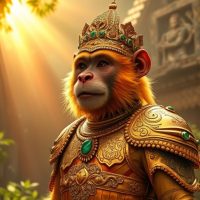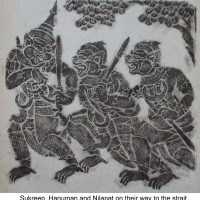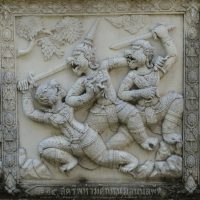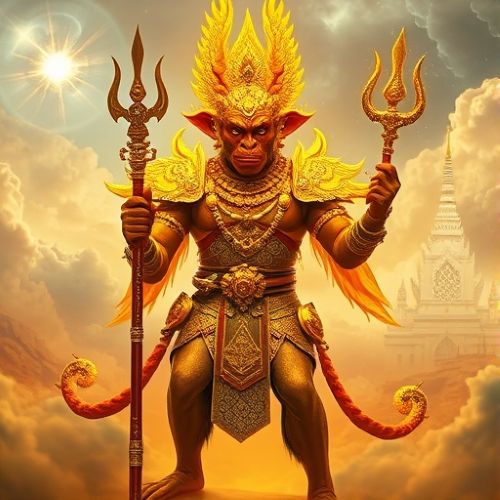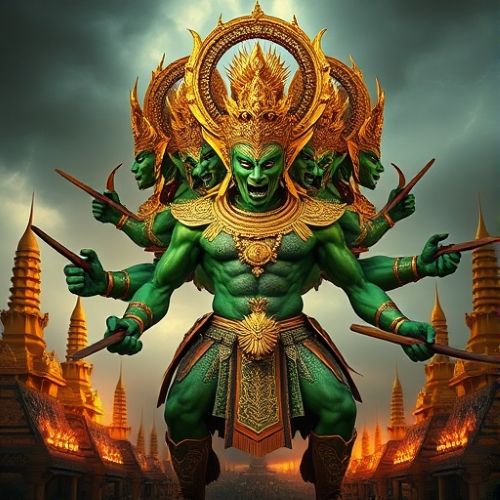Sukreep : The Hero Monkey
Listen
At a glance
| Description | |
|---|---|
| Origin | Thai Mythology |
| Classification | Demigods |
| Family Members | Phra Athit (Father), Kala Acana (Mother) |
| Region | Thailand |
| Associated With | Warrior, Royalty |
Sukreep
Introduction
Sukreep (สุครีพ), also known as Sukhreep or Sukhrip, stands as one of the most celebrated heroes in Thai mythology, deeply rooted in the Ramakien—Thailand’s grand retelling of the Indian Ramayana. Revered as the monkey king of Keetkin City, Sukreep represents loyalty, justice, and courage. In the Ramakien, he serves as a steadfast ally to Phra Ram (Rama), aiding him in his quest to rescue Nang Sida (Sita) from the clutches of the demon king Thotsakan (Ravana). His character encapsulates the Thai ideals of duty and honor, seamlessly blending Hindu mythological roots with Thai cultural identity. Through centuries of storytelling, theatre, and temple art, Sukreep’s legend has come to symbolize the triumph of virtue over deceit.
Physical Traits
In Thai depictions, Sukreep is often portrayed as a vanara—a monkey-like being combining the agility of an animal with the nobility of a divine warrior. His skin is typically golden, symbolizing purity, valor, and divine origin. This hue also aligns him with his father, Phra Athit, the Sun God. In traditional Khon masked performances, Sukreep’s mask and costume are richly adorned with gold and green details, featuring a regal crown and ornate jewelry that mark his royal heritage. He embodies both physical power and grace, with a muscular build reflecting his strength and a poised stance that signifies his intelligence and leadership. According to Thai legend, his monkey form resulted from a hermit’s enchantment, a transformation that endowed him with supernatural agility and resilience while retaining his divine essence.
Family
Sukreep’s lineage anchors him within the celestial hierarchy of Thai mythology. He is the son of Phra Athit, the radiant Sun God, and Kala Acana, a celestial maiden. This divine parentage grants him both spiritual authority and supernatural strength. His brother, Phali (Vali), was the former ruler of the monkey kingdom of Khitkhin. Their relationship is marked by rivalry and tragedy—Phali banishes Sukreep after a misunderstanding, setting the stage for their eventual confrontation. Despite their discord, Sukreep’s story is one of reconciliation and destiny; after Phali’s death, he inherits the throne and restores peace to the kingdom. His consort, Dara (Tara in Indian traditions), symbolizes loyalty and virtue, often portrayed as a stabilizing force in his life. Together, their union mirrors cosmic balance—sun and earth, courage and compassion.
Other names
Across literary and oral traditions, Sukreep is known by several names that reflect both linguistic evolution and cultural adaptation. In Thai script, his name appears as สุครีพ (Sukhreep), while Sanskrit sources identify him as Sugriva. These variations—Sukhrip, Sukrip, and Sukhreep—emerge from regional pronunciations and transliterations through centuries of storytelling. Each version underscores the shared mythological roots that connect Thai and Indian epic traditions. The continuity of his identity across languages also demonstrates the fluidity of myth, where characters transcend boundaries and adapt to new cultural landscapes while retaining their essence.
Powers and Abilities
Sukreep’s might is legendary, blending divine heritage with the physical prowess of the vanara race. His strength is said to rival that of a thousand warriors, and his agility allows him to leap across oceans and scale mountains effortlessly. As commander of the monkey armies, his leadership and strategic brilliance are as vital as his combat skills. His ability to unite diverse tribes under a common cause makes him one of the most effective generals in the Ramakien. Beyond brute strength, Sukreep possesses divine protection inherited from his father, granting him resistance against demonic magic and harm. In several retellings, Sukreep also demonstrates shapeshifting powers, allowing him to adapt during battle—a trait symbolizing adaptability and wit. Unlike his brother Phali, who embodies raw dominance, Sukreep’s power lies in discipline, intelligence, and moral clarity. His guidance and coordination of the vanara forces were instrumental in building the great bridge to Lanka, a pivotal moment in the epic that signifies human (and divine) cooperation in the pursuit of righteousness.
Modern Day Influence
Sukreep’s legacy extends far beyond the pages of ancient epics, remaining a vibrant presence in Thai art, culture, and national identity. He is immortalized in the Khon masked dance drama, one of Thailand’s most revered classical performances, where his character embodies bravery and moral duty. These performances often portray his emotional depth—the anguish of exile, the resolve of leadership, and the triumph of justice. Temple murals, particularly at Wat Phra Kaew (the Temple of the Emerald Buddha) in Bangkok, feature intricate scenes of Sukreep’s adventures, his battles, and his alliance with Phra Ram.
In modern media, Sukreep continues to inspire reinterpretation. Thai graphic novels, television adaptations, and animated films retell his story for younger audiences, emphasizing his virtues of loyalty and courage. Artists and designers have even reimagined him as a symbol of resilience and teamwork, reflecting Thai cultural values in contemporary forms. Moreover, Sukreep’s image often appears in educational and tourism initiatives promoting Thailand’s mythological heritage, bridging traditional lore with national pride.
His influence also reaches beyond Thailand. In global reinterpretations of the Ramayana, Sukreep is recognized as the archetype of the loyal friend and just ruler—a being who overcomes personal loss to serve a higher purpose. In Thai philosophy and popular thought, he represents the solar principle of renewal: light overcoming darkness, knowledge triumphing over ignorance, and justice prevailing against tyranny.
Related Images
Source
Wikipedia. (2004, April 28). Ramakien. Retrieved November 6, 2025, from https://en.wikipedia.org/wiki/Ramakien
Godchecker. (2019, May 5). SUKREEP – the Thai Hero God (Thai mythology). Retrieved November 6, 2025, from https://www.godchecker.com/thai-mythology/SUKREEP/
Niyom, W. (2025, April 4). Eggsquisitely Mythical #17: Thailand. Retrieved November 6, 2025, from https://www.weraniyom.com/post/eggsquisitely-mythical-17-thailand
Cambridge University Press. (2025, May 27). Indian Myth, Korean Wave, and ‘Thainess’: Politics of Hybridity in Thai Literature in the 21st Century. Trans-Trans-Regional and National Studies of Southeast Asia.
Lebarty.bongchong.com. (2024, August 19). Thai Mythology – Lebarty. Retrieved November 6, 2025, from https://lebarty.bongchong.com/thai-mythology/
Wikipedia. (2021, September 30). Sang Thong. Retrieved November 6, 2025, from https://en.wikipedia.org/wiki/Sang_Thong
Allen, P. J., & Saunders, C. (2019). Sukreep. Editors, Godchecker.com. Retrieved November 6, 2025, from https://www.godchecker.com/thai-mythology/SUKREEP/
Bhumibol, A. (1999). Ramakien: The Thai Epic. Bangkok: Thai Cultural Press.
Wyatt, D. K. (2003). Thailand: A Short History. Yale University Press.
Terwiel, B. J. (2011). Monks and Magic: An Analysis of Religious Ceremonies in Central Thailand. Silkworm Books.
Brandon, J. R. (1967). Theatre in Southeast Asia. Harvard University Press.
Keyes, C. F. (1987). Thailand: Buddhist Kingdom as Modern Nation-State. Westview Press.
Frequently Asked Questions
What is lorem Ipsum?
I am text block. Click edit button to change this text. Lorem ipsum dolor sit amet, consectetur adipiscing elit. Ut elit tellus, luctus nec ullamcorper mattis, pulvinar dapibus leo.
What is lorem Ipsum?
I am text block. Click edit button to change this text. Lorem ipsum dolor sit amet, consectetur adipiscing elit. Ut elit tellus, luctus nec ullamcorper mattis, pulvinar dapibus leo.
What is lorem Ipsum?
I am text block. Click edit button to change this text. Lorem ipsum dolor sit amet, consectetur adipiscing elit. Ut elit tellus, luctus nec ullamcorper mattis, pulvinar dapibus leo.
What is lorem Ipsum?
I am text block. Click edit button to change this text. Lorem ipsum dolor sit amet, consectetur adipiscing elit. Ut elit tellus, luctus nec ullamcorper mattis, pulvinar dapibus leo.
What is lorem Ipsum?
I am text block. Click edit button to change this text. Lorem ipsum dolor sit amet, consectetur adipiscing elit. Ut elit tellus, luctus nec ullamcorper mattis, pulvinar dapibus leo.


